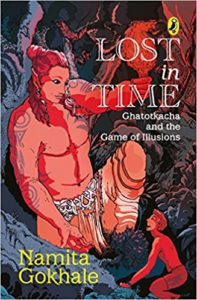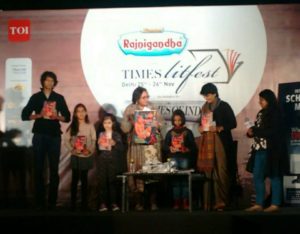In conversation with Namita Gokhale on her “Lost in Time”, Times of India LitFest, New Delhi ( 26 Nov 2017)
 Lost in Time: Ghatotkacha and the Game of Illusions is Namita Gokhale’s first young adult novel, published by Puffin India but not her first publication for children – a few years ago she published the hugely successful Puffin Mahabharata.
Lost in Time: Ghatotkacha and the Game of Illusions is Namita Gokhale’s first young adult novel, published by Puffin India but not her first publication for children – a few years ago she published the hugely successful Puffin Mahabharata.
Lost in Time: Ghatatkacha and the Game of Illusions is the story told in the voice of young Chintamani Dev Gupta who is sent packing to a birding camp near Sat Tal lake. Chintamani, AKA Chintu Pintu, is inexplicably transported to the days of the Mahabharata. Trapped in time, he meets Ghatotkacha and his mother Hidimbi. The gentle giant, a master of illusions and mind boggling Rakshasa technology, wields his strength with knowledge and wisdom, and imparts the age old secrets of the forest and the elemental forces. In his company, Chintamani finds himself in the thick of the most enduring Indian epic – the Mahabharatha. A tender look at a remarkable friendship as well as the abiding riddles of time , this visual treat of a book casts light on the first born son of the Pandavas, – one who finds rare mention in the fading pages of myth and legend. But there’s more to the story. Aided by Dhoomavati, the mistress of smoke and secrets, Chintamani returns to his own time – our time – and urban life in Gurgaon, AKA Gurugram. The rhythm of modern urban life, and his passion for football, cannot erase the memories of his incredible encounter with the past, and his friendship with Ghatotkacha which defies the barriers of time.
urban life, and his passion for football, cannot erase the memories of his incredible encounter with the past, and his friendship with Ghatotkacha which defies the barriers of time.
It is a lovely book about a minor but significant character of the Mahabharata. Namita Gokhale in her story has told the story tenderly, focusing not just on the legend of Ghatotkach but placing it well within the context of the major episodes of the epic. Yet there are two elements in the book that are baffling. One is the illustration of Ghatotkach. According to legend he is given the name that he has because of his bald pate shaped like a ghada/ an urn. Yet the illustrations on the book cover and accompanying the text show him to have beautiful long hair. The second was the promotion for the Puffin Mahabharata written by Namita Gokhale ten years ago. Chintamani after returning to modern India is intrigued by the epic and goes to his bookshelf to locate it. He recalls his mother buying this particular version of the epic and then proceeds to quote the book blurb. Curious way of promoting the previous book given it has already been mentioned in the opening pages of Namita Gokhale’s publications.
All said and done it is a beautifully written book especially the stunning passages of the milky way, playing with the sunlight and weaving a hammock out of cobwebs. Absolutely gorgeous!
On Sunday, 26 November 2017, at the Times of India LitFest, New Delhi, Namita Gokhale’s book was launched. After which I was in conversation with her. Watch the event here:
28 Nov 2017


